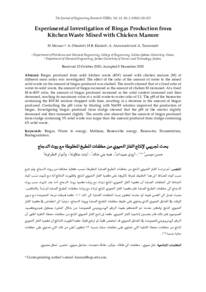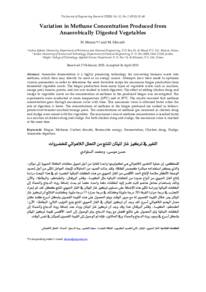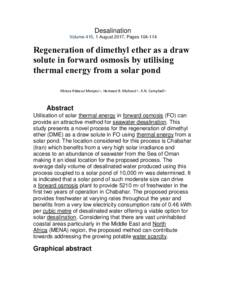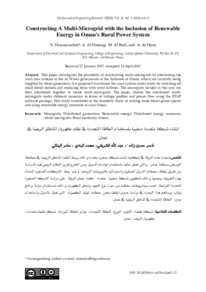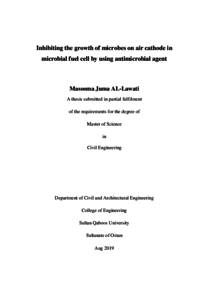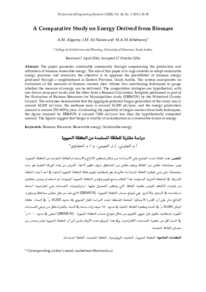Document
Experimental investigation of biogas production from kitchen waste mixed with chicken manure.
Contributors
Publisher
Sultan Qaboos University.
Gregorian
2016
Language
English
English abstract
Biogas produced from solid kitchen waste (KW) mixed with chicken manure (M) at different mass ratios was investigated. The effect of the ratio of the amount of water to the mixed solid waste on the amount of biogas produced was studied. The results showed that at a fixed ratio of water-to-solid waste, the amount of biogas increased as the amount of chicken M increased. At a fixed M-to-KW ratio, the amount of biogas produced increased as the solid content increased and then decreased, reaching its maximum value at a solid waste-to-water ratio of 1:1. The pH of the bioreactor containing the KW-M mixture dropped with time, resulting in a decrease in the amount of biogas produced. Controlling the pH value by titrating with NaOH solution improved the production of biogas. Investigating biogas produced from sludge showed that the pH of the reactor slightly decreased and then increased slightly. The results also showed that the amount of biogas produced from sludge containing 3% solid waste was larger than the amount produced from sludge containing 6% solid waste.
Member of
ISSN
1726-6742
Resource URL
Citation
Mousa, H., Obaidat, A., Khaled, H. B., Alawaneh, A., & Tarawneh, A. (2016). Experimental investigation of biogas production from kitchen waste mixed with chicken manure. The Journal of Engineering Research, 13 (2), 115-123.
Arabic abstract
تم دراسة الغاز الحيوي المنتج من مخلفات المطبخ الصلبة المخلوطة بنسب كتلية مختلفة من روث الدجاج. وتم تتبع نسب المياه المضافة إلى هذا الخليط لمعرفة تأثيرها على كمية الغاز الحيوي المنتج. وأظهرت النتائج أنه مع تثبيت نسب المياه المضافة إلى المخلفات الصلبة أن كمية الغاز الحيوي المنتج تزداد مع زيادة كمية روث الدجاج. أما عند تثبيت نسب روث الدجاج إلى مخلفات المطبخ الصلبة فإن كمية الغاز الحيوي المنتج تزداد مع زيادة مخلفات المطبخ الصلبة ثم تبدأ بالتناقص، بحيث تصل إلى أقصى قيمة لها عندما تكون نسبة المخلفات الصلبة إلى الماء 1 : 1. كما هبطت درجة الحموضة مع مرور الوقت في المفاعل الحيوي الذي يحتوي على خليط مخلفات المطبخ الصلبة وروث الدجاج، مؤديا إلى انخفاض في كمية الغاز الحيوي المنتج. ولكن عندما تم التحكم بقيمة الرقم الهيدروجيني للحموضة من خلال المعايرة بمحلول هيدروكسيد الصوديوم فإن ذلك قام بتحسين إنتاجية الغاز الحيوي. كما إن تتبع الغاز الحيوي المنتج من مخلفات محطة التنقية أظهر أن الرقم الهيدروجيني للحموضة في المفاعل الحيوي قد انخفض قليلا ثم ارتفع قليلا. كما أظهرت النتائج أن كمية الغاز الحيوي المنتج من مخلفات محطة التنمية التي تحتوي على مخلفات صلبة بنسبة 3% تكون أعلى من تلك التي تحتوي على مخلفات صلبة بنسبة 6%.
Category
Journal articles

